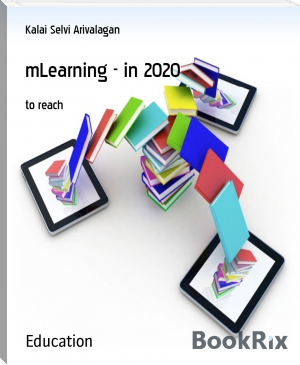INNOVATIONS IN SCIENCE, TECHNOLOGY AND MATHEMATICS EDUCATION IN NIGERIA by Ebele C. Okigbo, Nneka R. Nnorom, Ernest O. Onwukwe (the ebook reader .txt) 📖

- Author: Ebele C. Okigbo, Nneka R. Nnorom, Ernest O. Onwukwe
Book online «INNOVATIONS IN SCIENCE, TECHNOLOGY AND MATHEMATICS EDUCATION IN NIGERIA by Ebele C. Okigbo, Nneka R. Nnorom, Ernest O. Onwukwe (the ebook reader .txt) 📖». Author Ebele C. Okigbo, Nneka R. Nnorom, Ernest O. Onwukwe
Purpose of the Study
To investigate the difference in mean achievement scores of male and female students taught physics concepts.
To find out the interaction effect of teaching methods and gender on students’ achievement in physics.
Research Questions
The following research questions guided the study.
What is the difference in mean achievementof male and female students on academic achievement in physics?
What is the interaction effect of treatment and gender on students’ academic achievement in physics?
Hypotheses
The following hypotheses were formulated and tested at 0.05 level of significance.
There is no significant difference between the mean achievement scores of male and female students in physics.
There is no significant interaction effect of teaching methods and gender on students’ achievement in physics.
Methods
Quasi-experimental design has been used for this study, specifically, non-equivalent control group design. The population is total of 3,438 Senior Secondary one (SS 1) students from all the state government owned co – educational secondary schools in Awka Education Zone of Anambra state. The logic behind selection of co-educational secondary schools is to create the same study environmental condition for both genders. While SS 1 students were chosen because SS 1 is the foundation class for science students and if captured at that level the students might likely study physics in SS 2 and SS 3. The sample was made of 167 (77 males and 90 females) SSI students. 30 multiple items questions about electric charge and electric field were used as data collection tool. After the classroom teachers who acted as research assistants had been adequately briefed and had demonstrated competence in the successful implementation of the instructions, pretest was applied on groups a week before the actual teaching of the electric charge and electric field concepts. Experimental groups were taught using CAI with animation. Conventional lecture method was used for groups which are known as control groups. Posttests were administered to both groups one week after the treatments. In analysis of data, descriptive and inferential statistics were used. ANCOVA was used for testing the hypotheses. In this case, pre-test scores serve as covariate measures. In this study, steps below were observed with control and experimental groups in 5 weeks of process. At the end of pretest, subjects of electric field, types of charge, charge and charge interaction, charge as a quantity and production of charges were taught to both groups by their class teachers who served as research assistants in line with the lesson plan prepared by the researchers. Control groups were exposed to the physics concepts using conventional method. Experimental groups were taught using CAI with animation package produced by the researchers from the same field with the lesson plan. The package adopted the tutorial modes of CAI. After the treatment has been made, the same instrument was reshuffled and used as post-test.
Results
Research Question 1
What is the difference in mean achievement of male and female students on academic achievement in physics?
Table 1: Mean and Standard Deviation Scores of Students’ Achievement Score by Gender
Pre-test Post-test
Table 3 shows that male students had higher mean achievement score of 56.99 than female students which had 54.67 making the mean difference in achievement to be 1.72 in favour of the male students. This implies that male students achieved better than the female students when taught physics concepts. Similarly, the standard deviations were 17.67 for males and 14.38 for females showing the homogeneity of the scores.
Research Question 2
What is the interaction effect of treatment and gender on students’ academic achievement in physics?
Table 2: Mean and Standard Deviation Scores of Students’ Achievement Score by Treatment and Gender
Teaching Strategy
Gender
N
Post-test Mean
SD
CAI with Animation (E)
Male
Female
37
31
20.78
19.71
4.89
5.19
Conventional Method(C)
Male
Female
40
59
20.62
20.31
5.00
5.4
E= Experimental group; C= Control group
Table 2 shows that male perform more than female using experimental and control groups. This is shown by the mean scores of 20.78 (for E) and 20.62 (for C) of males against 19.71 (for E) and 20.31 (for C) of females. However, to determine if these observed differences were significant, hypotheses were tested at 0.05 level of probability.
Testing of Hypotheses
Null Hypothesis 1
There is no significant difference between the mean achievement scores of male and female students in physics.
Table 3: ANCOVA Test of Significant Difference between the Mean Achievement Scores of students by Gender
Type III Sum Mean
Source of Squares df Square F Sig. Decision
Corrected Model 30784.789a 4 7696.197 107.782 .000
Intercept 22762.906 1 22762.906 318.786 .000
Pretest 1039.409 1 1039.409 14.557 .000 S.
Gender 45.951 1 45.951 .644 .424 NS.
Error 11567.618 162 71.405
Total 561148.000 167
Corrected Total 43352.407 166
S= Significant at 0.05 probability level NS= Not Significant at 0.05 probability level
The data on Table 3 shows that gender is not significant on students’ achievement in physics. This is revealed by the calculated F (0.644) by gender is 0.424 compare to p˂0.05 alpha level. Since the F-value is higher than that of alpha level, the null hypothesis one is therefore upheld. This implies that gender have no significant influence on the students’ achievement in physics.
Null Hypothesis 2
There is no significant interaction effect of teaching methods and gender on students’ achievement in physics.
Table 4: ANCOVA Test of Interaction Effect of Methods and Gender on students’ Achievement Scores of
Type III Sum Mean
Source of Squares df Square F Sig. Decision
Corrected Model 30784.789a 4 7696.197 107.782 .000
Intercept 22762.906 1 22762.906 318.786 .000
Method*Gender 472.337 1 472.337 6.615 .011 S.
Error 11567.618 162 71.405
Total 561148.000 167
Corrected Total 43352.407 166
S= Significant at 0.05 probability level NS= Not Significant at 0.05 probability level
From Table 4, it can be observe that the significant of F (6.615) for the interaction (method*gender) is 0.011, p˂0.05. Facts emerging from the table show that there exists a significant interaction effect between methods of instruction and gender on students’ achievement. Thus, the null hypothesis 2 is rejected and we upheld that there is significant interaction effect of methods and gender on students’ achievement in physics.
The mean scores are displayed graphically (Fig. 1) and it is evident that there is an interaction.
Fig. 1: Interaction Effects of Teaching Method and Gender on Students’ Achievements Physics.
Discussion of Results
The result of this study showed that difference exists between the mean gain score in achievement of male and female students taught physics. However, hypotheses testing reveal that this difference in the mean achievement scores of male and female students taught physics is not significant. This finding is in conflict with those of Pepple (2015), Stephen (2010) and Eriba (2006) which in their various studies found gender differences in favour of male students. In a study by Eriba and Sesugh (2006) on gender differences in achievement, they found that boys out-performed girls in science and mathematics achievement. In support of this, People (2015) findings revealed that senior secondary male chemistry students achieve better than their female counterpart using CAI package instructional strategy.
The present study agree with that of Gana and Barnabas (2014); Michael, Omiola, Awoyemi and Mohammed (2014) and Keziah (2011) which reported that gender had no influence on academic achievement of students. Their findings also revealed that gender has no significant effect on the academic achievement of students taught using multimedia-based instructional packages.
Higher achievement of male students in experimental groups (both in pre-test and post-test) could be attributed to the fact that some female students believe that science is too difficult and not that important for their future. This also could be due to the fact that males are generally more sensible to visual stimuli (like graphics, images, charts and so on) than females. This study therefore asserts that students’ academic achievement is not a function of gender.
Hypothesis two predicted that there would be no significant interaction effects of methods of instruction and gender on students’ academic achievement in physics. But the finding from analysis on Table 4 revealed that there is a significant interaction effect of methods of instruction and gender on students’ academic achievement in secondary school physics. Also the plot in Fig. 1 shows that for experimental groups, male students achieved higher on Electric Charge and Electric Field Achievement Test (ECEFAT) compared to female students. However, for control groups male students achieved lower on ECEFAT compared to female students. This implies that female students achieved better than male students using conventional method of instruction. Notwithstanding, when exposed to Computer Assisted Instruction (CAI) with animation method of instruction although both male and female students benefited positively, male students achieved better than female students (Fig. 1).
This is in line with the findings of Pepple (2015) who ascertains that the effect of CAI with animation on students’ academic achievement depends on gender in favour of male in chemistry. Hence, CAI though it enhances student level of achievement it is gender sensitive. Male students are predicted to benefit more than female students. This is in conflict with the findings of Michael, Omiola, Awoyemi and Mohammed (2014) who reported no significant interaction effect of methods and gender in mathematics. The inconsistencies in the findings of studies reviewed are an indication that the gender factor in achievement remains an issue requiring diversified attention.
Conclusion
Based on the findings of this study, the following conclusions were made. The result of this study provide empirical evidence that students’ academic achievement in secondary school physics depend on the method of instruction adopted and are not influenced by gender. However, experimental groups did interact significantly with gender to influence students’ academic achievement in secondary school physics.
Recommendations
Based on the findings of this study, the following recommendations were made.
Students irrespective of gender should have equal opportunity and the level of motivation to learn.
Stakeholders and NGOs should encourage and equipschools with new technology and computers for easy learning.
References
Abubakar, R. B. and Uboh,V.(2010).Breaking the gender barrier in enrolment and academic
achievement of Science and Mathematics students. Akoka Journal of Pure and Applied ScienceEducation,10(1); 203-213
Adigun, J., Onihinwa, J., Irunokhai, E, Sada, Y. & Adesina, O. (2015). Effect of gender on
Students’ academic performance in computer studies in secondary schools in New Bussa, Borgu LGA of Niger state.Journal of Education and Practice, 6(33);1-7.
Ajayi, O.K and Muraina,K. O.(2011). Parents education ,occupation and real mothers age as
predictors of students achievement in Mathematics in some selected schools in Ogunstate,Nigeria. Academic Online Journal, 9, Issues 2.
Anene, G. U. (2005). Home economics and academic performance of a child. Journal of
Home Economics Research, 6 (1); 99-103
Atadoga, M.M, Zaria, A.B, Mari, J.S & Danjuma, A.B (2016). Effects of CAI on academic achievement of Nigeria certificate in education physics students in Niger state, Nigeria. Report and opinion, 8 (1); 39 – 46.
Ayodele, C.S, & Adebiyi, D.R. (2013). Study habits as influence of academic performance of university undergraduates in Nigeria. Research Journal in Organizational psychology& Educational Issues, 4(3,4); 42-44.
Eriba, J.O. & Sesugh, A. (2006).Gender differences in achievement in calculating reacting masses from chemical equation among secondary school students in Markurdi Metropolis. Educ. Res. Rev., 1 (6); 170-173
Ezeani, I.U. (2004). Principle and methods of teaching (2nd edition). Onitsha: West and Solomon Publishing Company Limited.
Gana, C.S. & Barnabas, C.M (2014). Effect of computer assisted instruction with
animation on achievement of students, of college of education Minna in quantum physics. In D. Mogari (Ed), Towards Effective Teaching and Meaningful Learning in Mathematics, Science and Technology. Proceedings of the 5th conference of the ISTE international conference (pp. 342 – 353). UNISA, South Africa.
Gender Equality Commission of the Council of Europe
 The desire to acquire knowledge about the surrounding world and human society is quite natural and understandable for a person. Life is so developed that an uneducated person will never occupy a high position in any field. Humanity in its mass, and each person individually, develops objectively, regardless of certain life circumstances and obstacles, but with different intensity. The speed of development depends on the quality of training.
The desire to acquire knowledge about the surrounding world and human society is quite natural and understandable for a person. Life is so developed that an uneducated person will never occupy a high position in any field. Humanity in its mass, and each person individually, develops objectively, regardless of certain life circumstances and obstacles, but with different intensity. The speed of development depends on the quality of training.




Comments (0)